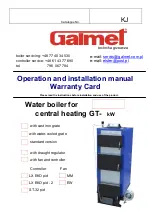
BOILER MOUNTING
13
3.4.
Mounting the burner
The ENP boilers are overpressure boilers and it is necessary to take into account the static
pressure of counter-pressure in the combustion chamber to select the proper burner. The
dimensions of the flange on the boiler door for mounting the burner as well as of the support
screws are according to DIN 4789. The part of the fuel pipes, which are connected to the
burner must have sufficient length and must be flexible, in order to allow the opening of the
boiler door.
The gap around the boiler flange is filled by fireproof ceramic material. The supply of fuel must
be adjusted at the nominal power of the boiler, by selection of the appropriate atomizer.
For the mounting of the burner on the boiler, you must take care of the following:
The burner must be well fixed on the special flange of the boiler. The four screws must be
fastened well, so that the burner is not loose on the boiler.
The sealing flange of the burner ensures insulation from combustion gas leaks. Take care
that it does not break.
The injection neck of the burner must be deep enough in the boiler, so that its edge reaches
deeper than the plate that carries the tubes. The burners with long injection neck are more
proper for boilers made of steel.
The burner must be positioned horizontally and parallel to the combustion chamber.
The position of the burner must be correctly aligned in connection with the center of the
combustion chamber. In this way a uniform flame is developed and a better distribution of
the thermal load is ensured.
The door must fit well on the sealing cord in order not to have combustion gas leaks.
The space between the injection neck of the burner and the door of the boiler must be
insulated with fireproof material.
The fireproof material of the door of the boiler must be replaced with new material, if it gets
damaged during the use.
The burner neck must penetrate inside
the combustion chamber in a way that the
entire heat exchange surface of the fire
chamber is performed uniformly by the
exhaust gas. If the neck of the burner is of
very small size, the flame goes directly to
the fire tubes, a fact that results in excessive
increase of the thermal strain of the boiler.
Legend
1.
Burner
2.
Burner mounting flange
3.
Door insulation with fire proof material
4.
Insulation around the injection neck of the
burner
5.
Boiler door
6.
Ceramic insulation flange
7.
Sealing cord
8.
Burner injection neck
9.
Tube
10. Boiler front plate














































